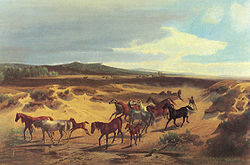Dairyman horse
| Dairyman horse | |
|---|---|

Senner horses in the Moosheide nature reserve |
|
| Important data | |
| Origin: | Germany |
| Main breeding area: | Senne |
| Distribution: | very low |
| Stick measure : | 159 - 165 cm |
| Colors : | all colors possible |
| Main application area: | Riding horse |
The Senner horse is a light, medium-sized horse of the Anglo-Arabian type . It's elegant and spirited. All colors are possible. The height is 159 to 165 cm. In the Red List of the Society for the Preservation of Old and Endangered Pet Breeds eV (GEH) the stock of the Senner horse is classified as extremely endangered .
Background information on horse evaluation and breeding can be found under: Exterior , interior and horse breeding .

Exterior / interior
Shepherds were bred as riding horses. They are tough, frugal horses with good riding horse points. Their very good fertility is remarkable. The animals are mainly used in eventing and show jumping.
The original features of the Senner horse are the occasional eel line and recognizable zebras on the foals' legs. You can only assign basic colors to all horses from the age of 5.
Breeding history
The Senner horse is one of the oldest known horse breeds in Germany. Wild horses in the Senne heathland were first mentioned in a document in 1160. In the Middle Ages, the dairyman horses were a sought-after breed. Bernhard I von Oesede , the Bishop of Paderborn, gave the third part of his untamed mares in a donation to the Hardehausen Monastery he founded . In the Middle Ages, dairy farmers were a coveted cultural breed. When the wild perde population was recorded on behalf of the wife of Count Bernhard VII von Lippe in 1493 , the number of individuals was 64, including 23 broodmares and 18 foals, which already indicates good fertility at that time. The stud building, which has existed since the 16th century, is located near the Lopshorn hunting lodge in the Lippe district of Senne, and was used for relatively controlled breeding and stock monitoring. There was a wild animal stud farm until the early 20th century.
From the end of the 17th century Arab thoroughbreds were crossed, at the end of the 18th century English thoroughbreds and Anglo-Arabs, who still determine the type of the dairy breed.
The animals were kept in the wild all year round until 1803 , after which they were not kept outdoors in winter.
The breeding association for Senner horses eV leads to § 7 Animal Breeding Act the original stud book for the Senner.
Meaning of the dairymen for the heath in the dairymen
For more than 80 years the dairymen no longer grazed in the dairy. Since 2000, some Senner geldings and mares have been used to graze grass in the Moosheide nature reserve in the Senne and are kept on over 20 hectares of dry grass. On the one hand, this project is intended to preserve the shape of the landscape, because their feeding and treading behavior influenced the vegetation of the heathland.
On the other hand, characteristics of the horses should be preserved. Since the alpine dairy landscape is very poor in nutrients and offers few water points, the dairymen are very persistent and healthy.
See also
literature
- Thomas Kiper (ed.), Guido Sachse (author): Return of the dairymen's horses. The oldest German horse breed is returning to its homeland. Kiper, Bielefeld 2003, ISBN 3-936359-00-8 .
- Karl-Ludwig Lackner (Ed.): The "Senner". With an essay by Wolfgang von Unger. Kramer, Borgholzhausen 1996, ISBN 3-929653-03-6 .
- Cordula Marx, Agnes Sternschulte (ed.): "... so free, so strong ..." Westphalia's wild horses (= writings of the Westphalian Open Air Museum Detmold - State Museum for Folklore. Vol. 21). Klartext, Essen 2002, ISBN 3-89861-082-9 .
Web links
- Grazing project for Senner horses , Paderborn - Senne district biological station
- Breeding Association for Senner Horses eV
- The Senne: barren beauty